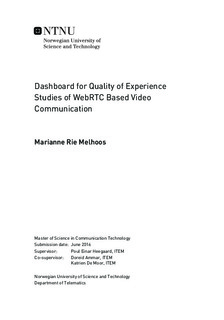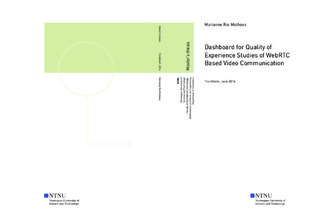| dc.description.abstract | WebRTC-based applications and services have become more and more popular over the last years. These types of applications support Real-Time Communication (RTC) with audio, video and sometimes also data sharing. WebRTC-based applications are trouble-free, require no installation, and are in-browser applications. A participant can connect and access these types of applications through a wide range of devices and can communicate with others in real-time, and exchange information instantly or with negligible delay.
Even though the performance of WebRTC-based applications and services are continuously improving, these applications and services face some challenges. For example, in a WebRTC-based conversation, there are a number of technical constraints (e.g. limited bandwidth) and parameters (e.g. packet loss, delay, etc.) that may cause an end-user to experience various negative quality deteriorations (e.g. video freezes, bad or no audio, etc.). As WebRTC-based applications and services are up and coming, it is important to address such issues.
To provide the best possible Quality of Experience (QoE), this requires lab studies and also large-scale ongoing lab studies in order to obtain a deep understanding of the various technical and non-technical factors that may have an influence on the QoE. Due to the high number of session-related parameters, these studies will provide a significant amount of data, all of which will need to be analyzed. Therefore in order to proceed further analysis, an analyzing tool is crucially needed.
To meet this need to provide an analyzing tool which is able to analyze large amounts data, this master thesis will present the implementation of a web interface, the WebRTC-dashboard. The WebRTC-dashboard utilizes session-related data from analyzing platforms in order to analyze n-party WebRTC-based video conversations. The WebRTC-dashboard supports to combine network statistics, subjective user feedback from different analytic platforms, and video recordings with the ability to replay them as they were in real-time. This WebRTC-dashboard also allows end-users to interact and customize an analysis for his/hers purpose, which opens the possibility to identify new correlations between various impacting factors.
This master thesis highlights the great potential the WebRTC-dashboard has and what it can accomplish. In the context of future development, this thesis will also discuss what challenges that have occurred during the development process, and how these challenges can be handled. | |

